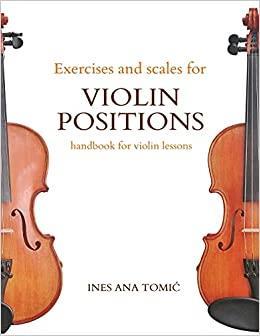Celia Cobb reviews a guide to shifting and position-work by Ines Ana Tomić

Exercises and Scales for Violin Positions: Handbook for Violin Lessons
Ines Ana Tomić
53PP ISBN 9798711917809
Studio Pizzicato £11.94
Allow me to introduce you to my new favourite shifting and position-work book. Ines Ana Tomić’s publication is a calm and extremely methodical approach to learning to shift to different positions and play in them.
The book begins with preparatory exercises credited to Paul Rolland, all intended to promote freedom of the left hand in preparation for beginning to shift. After this, each chapter introduces a new position, working systematically from second through to seventh. (If you prefer to present third position first, you could always just skip ahead to that chapter.)
Each position is dealt with in the same way – first, a photograph illustrating the physical placement of the hand on the string, then a quick exercise to get you there from first position, followed by a four-bar finger exercise on each string in the new position. After the position has been established, then comes the serious work of the shifting exercises. These are consistent throughout the book, so that by the time the student is introduced to the higher positions, they are already familiar with the format, which makes the upper positions feel like a natural next step, rather than something scary and unknown.
The book feels considered and friendly from the moment you open it – first, it is a lovely size (smaller than an average book of sheet music), there is plenty of white space, and the font size of the music is huge, without looking babyish. The exercises are short and there is a sense of orderly progression. There are also very few words throughout, and nothing superfluous is included, including three-octave scales. It seems almost churlish to point out the few small typos as they don’t detract from the content. The one thing that perhaps could have been included is a more formal presentation of the use of different finger spacings within each position. This is something that would of course be addressed within the context of a lesson, but it might have been helpful to have featured an explanation or diagram for students using the book at home with non-string playing parents. As a general point, the absence of much in the way of written instructions makes this a book to be used and talked about in lessons, rather than as a supplementary volume for independent learning by students.
I would suggest that this is a book to give to a student who is ready to start learning to shift and play in new positions, and who might enjoy the challenge of a ‘grown-up’ and methodical approach to position work. It is a book that pupils will return to as they develop their playing, and although its rather serious approach may not appeal to all students, I think that for many, the repetition and inevitable sense of progress will feel comfortable and unthreatening, and should produce good and, dare I say it, quick results. I will be using it on a regular basis in my teaching.
CELIA COBB











































No comments yet